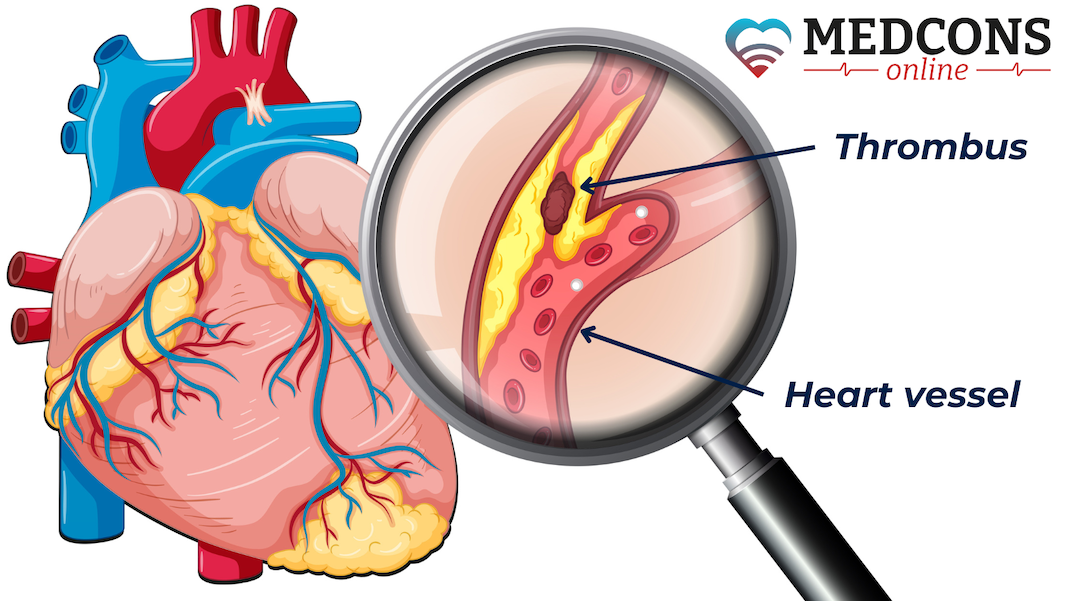
Circulatory disorders can have various origins. It is believed that the predominance of fatty foods in the diet leads to an increase in the level of cholesterol in the blood. Subsequently, it is deposited on the walls of the arteries. As a result, the vessel lumen narrows and the organ supplied with blood begins to lack nutrients, which causes the symptoms of atherosclerosis.
What is atherosclerosis
Atherosclerosis is a systemic disease affecting the arteries. Under the influence of certain factors, cholesterol and its esters are deposited on the walls of blood vessels. As a result, the buildup (plaques) form on the inner surface of blood vessels.
By origin, several types of atherosclerosis are distinguished:
- Haemodynamic. It more often develops in the presence of vascular disorders, in particular, hypertension. An inflammatory process on the vessel wall attracts immune cells, resulting in the formation of buildup. Over a long period of time, it increases in size.
- Metabolic. It occurs in connection with metabolic disorders with an increase in the level of low-density lipoproteins in the blood. It has been proved that patients with diabetes mellitus, obesity and sedentary lifestyle have a higher risk of developing this form of atherosclerosis.
- Mixed. In this case, the causes of both haemodynamic and metabolic form are present. This is the most common disease type.
Causes and symptoms of atherosclerosis
All people are susceptible to arterial atherosclerosis, but the latter does not always lead to complications. It is important when exactly the first signs of complications occur. The following groups of people develop complications related to atherosclerosis most often:
- Patients with hypertension. High blood pressure damages arterial walls. Cholesterol is deposited faster on the inflamed surface.
- People with metabolic disorders, such as diabetes mellitus and hormonal disorders.
- Patients with obesity. Due to improper nutrition, the odds of developing atherosclerosis is higher.
- People who lead a sedentary lifestyle. It negatively affects the blood flow, provoking congestion.
In addition to the above, frequent stress, hereditary predisposition and increased blood clotting are considered as atherosclerosis risk factors.
Even if you eat a lot of fatty foods, cholesterol is not deposited on the arterial walls if there is no damage or other provoking factors.
Classification and stages of disease
The formation of atherosclerotic plaque takes a long time, during which the disease goes through the following stages of development:
- Stage 1: asymptomatic. Signs of atherosclerotic plaques can be detected only with imaging studies.
- Stage 2: ischaemic. Due to the buildup, the lumen of the vessel narrows, as a result of which the organ supplied with blood ceases to receive enough blood.
- Stage 3: thrombonecrotic. Blood clots begin to accumulate at the site of the plaque, forming a thrombus.
- Stage 4: sclerotic. This stage is characterized by the fact that scar tissue is formed in place of the affected vessel. Accordingly, the artery no longer fulfils its functions.
The clinical presentation of the disease depends on which vessel is affected.
Atherosclerosis of the coronary arteries
When the heart vessels are affected, no signs of the disease are observed in the initial stages. Later on, symptoms indicating angina pectoris occur. This may be pain and a feeling of pressure in the chest. Often painful sensations irradiate to the left arm and sublumbar area.
Due to the restricted blood flow, the left ventricle increases in size.
In the initial stages of atherosclerosis, the changes are reversible with the right therapy.

Atherosclerosis of the lower extremity arteries
It is another common type of atherosclerosis. The initial stage can go on for a long time without manifesting itself in any way. The first signs may be pain during long walks. As the lumen of the vessel decreases, the distance that the patient can walk without pain shortens.
Another characteristic symptom of atherosclerosis of the lower extremity vessels is hair loss, deterioration of the skin and nails. This happens due to the lack of nutrition received by the tissues.
If untreated, the condition can lead to trophic changes. These can be necroses of tissues and trophic ulcers. With a large number of provoking factors and lack of therapy, gangrene may develop.
Atherosclerosis of cerebral vessels
When the nutrition of the brain tissue is insufficient, signs of the lack of oxygen appear, such as headaches, memory and concentration loss, excessive fatigue and lethargy.
With progression, there is nausea, a feeling of numbness in the extremities. If there is no treatment, the risk of stroke increases.
Atherosclerosis of the renal artery
Restricted blood flow through the kidney vessels leads to improper organ functioning. A characteristic sign of atherosclerosis in this case is arterial hypertension, which cannot be treated according to the traditional scheme.
The manifestations of other atherosclerosis types depend on the organ supplied by the damaged vessels. Thus, if it is abdominal vessels, stomach problems are observed, and in the case of intestinal arteries there are intestinal issues.
Diagnosis of atherosclerosis
If the disease is suspected, laboratory blood tests are done first to identify the disease risk factors. Also indicative of atherosclerosis are glucose, triglycerides and cholesterol level tests. In general, the diagnostic procedure depends on whether the patient has any signs of pathology.
If the patient has symptoms of blood circulation disorder, the primary task is to determine where it occurs. If there are signs of cardiac vascular damage, a resting and stress ECG and a blood test to determine the cardiac enzyme levels are recommended. The final diagnosis is based on the results of catheterization.
In addition, computed tomography may be used in diagnosis. A highly informative option is angiography. The procedure involves inserting a thin catheter through a large artery in the groin or arm, which gets to the affected vessel in order to detect a thrombus. The method is used to assess the heart arteries, the carotid artery, thoracic and abdominal aorta.
If there are no symptoms characteristic of atherosclerosis, laboratory blood tests to determine glucose, triglyceride and cholesterol levels may be done as preventive measures. These tests should be performed annually for every adult, even if there are no signs indicating abnormal changes in the blood vessels.
A carotid artery ultrasound or a cardiac CT can be used in patients who are at risk but manifest no characteristic symptoms as part of a preventive examination. The former method makes it possible to determine the carotid artery diameter and the presence of buildup on its wall. In general, ultrasound can study all arteries and veins, timely detecting blood flow disorders and vessel narrowing. CT is used to show the blood circulation. In this case, a contrast agent is used to make it more informative.
The diagnostic procedure for atherosclerosis depends on which organ is affected. If atherosclerosis of the heart vessels is suspected, ECG, including a stress exam, CT, catheterization and EchoCG are done. If the brain arteries are affected, ultrasound, CT, angiography are the informative options.
Atherosclerosis complications
Atherosclerosis-related complications depend on the plaque location. They may include:
- CHD, heart attack;
- severe digestive disorders;
- ischaemic stroke;
- blood clots and associated complications;
- aortic aneurysm;
- kidney dysfunction;
- trophic ulcers, gangrene;
- intestinal necrosis.
Treatment of atherosclerosis
Therapy for atherosclerosis can be aimed at preventing the formation of plaques and slowing the disease progress, as well as the treatment of conditions that provoke the development of atherosclerosis. The strategy is chosen on an individual basis after a complete examination.
Which doctor should I see
Given that the abnormal process can affect almost any vessel, the symptoms of the disease can refer the patient to one or another doctor. Most often the following specialists are visited with complaints:
- a neurologist - in case of headache, numbness and excessive weakness;
- a cardiologist - in case of heart pain, shortness of breath, high blood pressure;
- a angiologist - for pelvic pain, decreased sensation in the extremities.
Is vascular atherosclerosis reversible?
Today, there is no treatment method that would allow reversing the changes caused by atherosclerosis.
Therefore, therapy should be aimed at reducing the level of bad cholesterol, which will stop the process and prevent the development of dangerous complications.
Drug therapy for atherosclerosis
The development of atherosclerosis is associated with high cholesterol levels in the blood. However, other factors are also important. Therefore, high cholesterol alone is not a reason for prescribing drug therapy. The decision on the need for statins and other drugs is made by a doctor on the basis of a thorough examination.
It is worth noting that an effective way to reduce cholesterol is a healthy lifestyle. At the same time, under certain circumstances, correcting your meal plan or physical activity is not enough to reduce the values. In particular, this applies to patients with hereditary hypercholesterolaemia. In these situations, the doctor may prescribe drug therapy.
Administration of drugs in no way cancels the adjustment of diet and lifestyle.
Statins are part of traditional therapy for diseases associated with lipometabolic process disorders. The effect is ensured due to the ability of statins to inhibit the protein necessary for the production of cholesterol. Due to this, the body's cells have to take it from the blood, thus reducing the risk of plaque formation.
At the same time, not all patients tolerate statins. Intolerance may be manifested by severe muscle pain. If after reducing the dosage the side effects persist, patients with vascular atherosclerosis should consider the following alternatives:
- Inhibitors of cholesterol absorption in the intestine.
- Fibrinic acid derivatives.
- PCSK9 protein inhibitors.
The above-mentioned drugs can be combined with each other and used in addition to statins to get a more pronounced effect of lowering blood cholesterol values. The final decision on the choice of drugs is made by a doctor.
Another technique for lowering blood cholesterol levels is lipoprotein apheresis. The transfusion procedure is used to purify the blood from the fats contained in it. This method is especially useful for hereditary hypercholesterolaemia.
New data offer encouraging prospects for drug therapy
According to the latest scientific evidence, coronary atherosclerosis bears a remarkable resemblance to tumors. It starts with damage to the inner layer of the arteries, the endothelium. Factors such as high blood pressure, unhealthy diet and smoking play a role. As a result of the damage, low-density lipoprotein (LDL) cholesterol particles are deposited in the artery walls and cause a constant inflammatory response. This inflammation leads to the formation of plaques, composed of fat and dead cells, in the artery walls.
In addition to endothelial cells, as well as defense cells, vascular smooth muscle cells are also actively involved in the process of atherosclerosis development. They migrate into the plaque and form a strong sheath over it, which stabilizes the deposits.
Researchers at Columbia University found that these altered muscle cells behave similarly to cancer cells. They proliferate uncontrollably, sprout into surrounding tissues and develop resistance to natural cell death. They activate genetic and cellular networks that are also active in tumors, which can accelerate the development of vascular atherosclerosis.
However, this does not mean another risk of cancer. Although the altered muscle cells develop tumor-like properties, they do not form metastases. Growth is limited to the arteries. But this discovery opens new perspectives in treating the disease.
In a mouse model, scientists were able to show that the anticancer drug niraparib (a targeted drug from the PARP inhibitor group), which targets DNA damage repair, can slow the progression of the disease and even partially reverse it.
The results of this study offer reasonable hope for patients with one of the most devastating vascular diseases.
Endovascular procedures for atherosclerosis
In the case of plaque formation in the arteries, stents may be used. The procedure is minimally invasive. Instruments are inserted into the vessel. With the help of a balloon, the narrowed area is dilated, after which a stent is placed in this site to prevent re-stenosis.
Surgical treatments for atherosclerosis
When minimally invasive methods of treatment of atherosclerosis and drug therapy fail, a surgical procedure is indicated. As a rule, it is used when there is a high risk of life-threatening complications and can be:
- bypass surgery - to create a new blood passage bypassing the affected area;
- endarterectomy - to remove the affected part of the artery.
Atherosclerosis prognosis and prevention
The prognosis in atherosclerosis depends on a large number of factors, such as blood pressure values, dietary habits, bad habits and the patient's weight. It is important to understand that even after stenting or bypass surgery, atherosclerosis does not disappear.
For this reason, great attention is paid to the prevention of atherosclerosis, and everyone should be engaged in it without exception. The basic recommendations for atherosclerosis are as follows:
- correct the diet to include sufficient amounts of vitamins, fibre and reduce salty products and fats;
- avoid bad habits, especially smoking;
- follow an active lifestyle, especially if you have a sedentary job;
- take care of conditions that increase the risk of atherosclerosis, such as cardiovascular diseases, diabetes mellitus, hypertension, obesity and so on;
- bring your body weight to normal.
Second opinion in atherosclerosis
The second opinion is an opportunity to get advice from experienced European doctors. If atherosclerosis is suspected or has been detected, counselling may be required at the following stages:
- Selection of diagnostic methods. A complete examination is required to make a diagnosis. In case of doubt, the patient can provide a list of recommended procedures and ask the opinion of another doctor. The same applies to the evaluation of diagnostic results.
- Choice of drugs. Various medications are used to treat atherosclerosis. The experience of doctors in European clinics will allow you to choose a therapy that has already proved its effectiveness.
- Deciding upon a particular type of intervention. If there is a high risk of complications, the doctor may suggest surgery, but there may different ways to do it. With the help of a second opinion, it is possible to make a choice between a minimally invasive procedure or conventional surgery.
You can have an online conversation with the help of an interpreter, as well as to provide get a written reply based on your medical records and image files.
Conclusion
Atherosclerosis is a chronic disease and the likelihood of developing life-threatening complications depends on whether the correct treatment is chosen and how thorough the patient is in following the recommendations. For example, if you take medications for heart pain or migraines without taking care of high levels, atherosclerosis will progress.
References:
- Pathogenesis of atherosclerosis, Erling Falk, 2006.
- The Diabetes Mellitus-Atherosclerosis Connection: The Role of Lipid and Glucose Metabolism and Chronic Inflammation, Anastasia Poznyak, 2020.
- Research Progress on the Relationship between Atherosclerosis and Inflammation, Yuhua Zhu, 2018.
- Atherosclerosis, Peter Libby, 2019.


Comments — 0